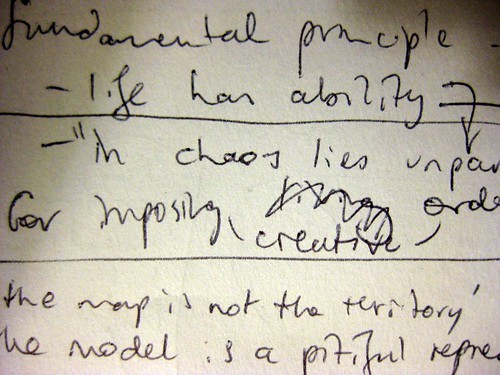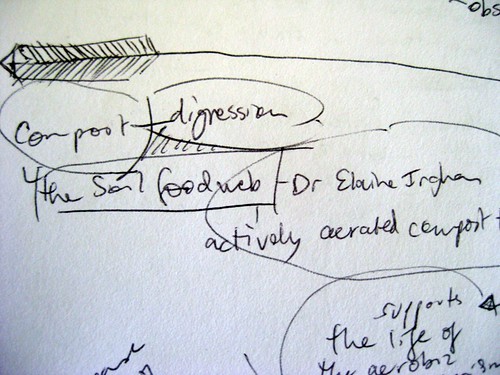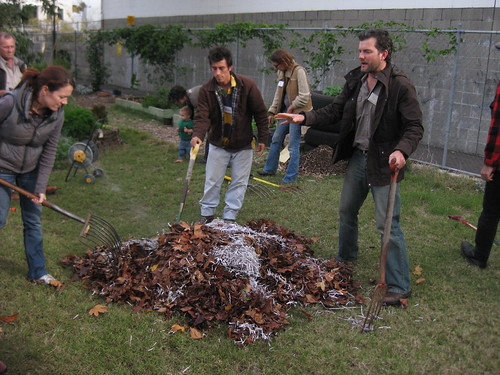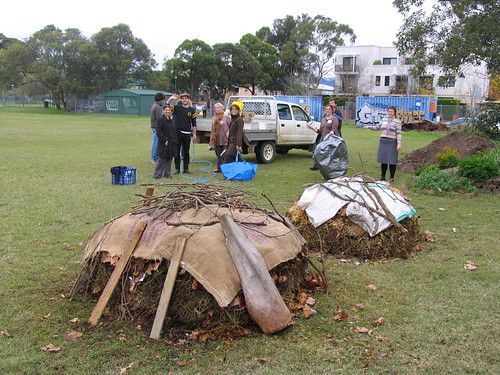
Last night at yoga, I bumped into Paul, one of the guys in the Sunday Permaculture class.
Paul: “I’m not really sure what I’m learning in that course.”
Me: “That’s a strange thing to say.”
Paul: “Yes, I suppose it is”.
But he’s right. I’m not really sure what I’m learning either.
That’s not to say I’m not learning. In fact – if by “learning” you mean the acquisition of new concepts, I’m brimming over with the pesky buggers. But what a strange breed of concepts these are! To what use can we put ’em?
Permaculture aint like other learning systems. In the web design course I took at TAFE 6 years ago, we strived to gain literacy in a strictly codified language. If you messed up one bit of typing, your web page would break. It was satisfying/maddening and appealed to the nitpicking pedantic grammatical-correctness zealot in me. In web design (or at least in some of its hard-core purist ghettos) the writing of the “correct code” and the resulting website take on equal value. “Code is poetry” (man).
Permaculture, on the other hand, seems to be founded on a whole teeming mess of principles and philosophies which lead to a less prescribed way of considering and interacting with the world around us. (Though I’m sure poetic coders would say web design is just the same).
Take this pearler, for example (it’s on page 12 of his Permaculture Designers Manual, should you wish to read it for yourself):
In chaos lies unparalleled opportunity for imposing creative order.
Holy gnomic utterances Batman!
Is Permaculture some sort of untangleable Zen-Mind experiment?
Bill Mollison (the man responsible for penning this corker) must be very confident that we, his humble disciples, will be such dedicated students that we’ll stroke our beards over that one for years to come.
And actually, he’d be right (at least as far as I’m concerned).
One of the things I find really appealing about this whole business (at least in the two weeks I’ve been doing it) is its refusal to hand over all the answers in a neat package. It’s resistant to dogma. It’s intellectually satisfying, in that way. I think. Unless you consider “resistance to dogma” to be a kind of dogma.
I guess the real point (and maybe this is what Paul-from-yoga is getting at, in his pedagogical uncertainty) is that the principles of Permaculture are but free-floating curiosities, until we try them out “in the real world”.
So that’s the question – what can I do today to test Mollison’s page 12 metaphysics?
* * *

On a more real-worldy note: this week we got to make our own collaborative compost heap!
It was the first time I’d done it from scratch. Before starting this course, I’ve always been of the “black-bin-in-backyard, chuck-in-foodscraps and hope-for-the-best” school. Up to now, composting has been a fascinating but random tool for observing organic decay. It’s been a great alternative to putting the vegies in the council rubbish bin, without any real method or strategy for how to best go about it.
But now we were making a compost heap for its own sake. Like cooking a soup, or baking a cake. (Actually, what it most seems to resemble is lasagne).

[Nick gets stuck in, Compost 101…]
A few years ago, my friend Paul Wakelam described this process as “making soil”. Which, I think, is incredible. You can make your own soil?!
(I always thought soil was just “dirt”. But then, what’s dirt?)
Anyway, here are some pictures Kirsten took at the big compost cook-up; and some more from my camera.

[The finished piles: Sunday class on the left, Saturday class on the right…]
And here’s a really fun video Kirsten made a few years back showing the compostery process in all its time-lapse-friendly glory, with her very cute and self-deprecating instructions for how you can D.I.Y.
And here’s the Milkwood Compost Calculator.